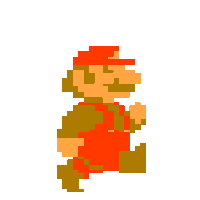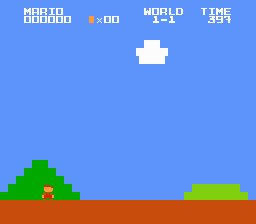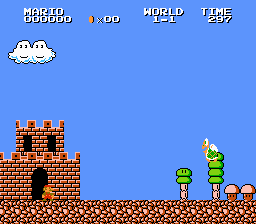An OpenAI Gym environment for Super Mario Bros. & Super Mario Bros. 2 (Lost Levels) on The Nintendo Entertainment System (NES) using the nes-py emulator.
The preferred installation of gym-super-mario-bros is from pip:
pip install gym-super-mario-brosYou must import gym_super_mario_bros before trying to make an environment.
This is because gym environments are registered at runtime. By default,
gym_super_mario_bros environments use the full NES action space of 256
discrete actions. To contstrain this, gym_super_mario_bros.actions provides
three actions lists (RIGHT_ONLY, SIMPLE_MOVEMENT, and COMPLEX_MOVEMENT)
for the nes_py.wrappers.JoypadSpace wrapper. See
gym_super_mario_bros/actions.py for a
breakdown of the legal actions in each of these three lists.
from nes_py.wrappers import JoypadSpace
import gym_super_mario_bros
from gym_super_mario_bros.actions import SIMPLE_MOVEMENT
env = gym_super_mario_bros.make('SuperMarioBros-v0')
env = JoypadSpace(env, SIMPLE_MOVEMENT)
done = True
for step in range(5000):
if done:
state = env.reset()
state, reward, done, info = env.step(env.action_space.sample())
env.render()
env.close()NOTE: gym_super_mario_bros.make is just an alias to gym.make for
convenience.
NOTE: remove calls to render in training code for a nontrivial
speedup.
gym_super_mario_bros features a command line interface for playing
environments using either the keyboard, or uniform random movement.
gym_super_mario_bros -e <the environment ID to play> -m <`human` or `random`>NOTE: by default, -e is set to SuperMarioBros-v0 and -m is set to
human.
NOTE: SuperMarioBrosRandomStages-* support the --stages/-S flag for
supplying the set of stages to sample from like -S 1-4 2-4 3-4 4-4.
These environments allow 3 attempts (lives) to make it through the 32 stages in the game. The environments only send reward-able game-play frames to agents; No cut-scenes, loading screens, etc. are sent from the NES emulator to an agent nor can an agent perform actions during these instances. If a cut-scene is not able to be skipped by hacking the NES's RAM, the environment will lock the Python process until the emulator is ready for the next action.
These environments allow a single attempt (life) to make it through a single stage of the game.
Use the template
SuperMarioBros-<world>-<stage>-v<version>
where:
<world>is a number in {1, 2, 3, 4, 5, 6, 7, 8} indicating the world<stage>is a number in {1, 2, 3, 4} indicating the stage within a world<version>is a number in {0, 1, 2, 3} specifying the ROM mode to use- 0: standard ROM
- 1: downsampled ROM
- 2: pixel ROM
- 3: rectangle ROM
For example, to play 4-2 on the downsampled ROM, you would use the environment
id SuperMarioBros-4-2-v1.
The random stage selection environment randomly selects a stage and allows a
single attempt to clear it. Upon a death and subsequent call to reset the
environment randomly selects a new stage. This is only available for the
standard Super Mario Bros. game, not Lost Levels (at the moment). To use
these environments, append RandomStages to the SuperMarioBros id. For
example, to use the standard ROM with random stage selection use
SuperMarioBrosRandomStages-v0. To seed the random stage selection use the
seed method of the env, i.e., env.seed(222), before any calls to reset.
Alternatively pass the seed keyword argument to the reset method directly
like reset(seed=222).
In addition to randomly selecting any of the 32 original stages, a subset of user-defined stages can be specified to limit the random choice of stages to a specific subset. For example, the stage selector could be limited to only sample castle stages, water levels, underground, and more.
To specify a subset of stages to randomly sample from, create a list of each
stage to allow to be sampled and pass that list to the gym.make() function.
For example:
gym.make('SuperMarioBrosRandomStages-v0', stages=['1-4', '2-4', '3-4', '4-4'])The example above will sample a random stage from 1-4, 2-4, 3-4, and 4-4 upon
every call to reset.
Info about the rewards and info returned by the step method.
The reward function assumes the objective of the game is to move as far right as possible (increase the agent's x value), as fast as possible, without dying. To model this game, three separate variables compose the reward:
- v: the difference in agent x values between states
- in this case this is instantaneous velocity for the given step
- v = x1 - x0
- x0 is the x position before the step
- x1 is the x position after the step
- moving right ⇔ v > 0
- moving left ⇔ v < 0
- not moving ⇔ v = 0
- c: the difference in the game clock between frames
- the penalty prevents the agent from standing still
- c = c0 - c1
- c0 is the clock reading before the step
- c1 is the clock reading after the step
- no clock tick ⇔ c = 0
- clock tick ⇔ c < 0
- d: a death penalty that penalizes the agent for dying in a state
- this penalty encourages the agent to avoid death
- alive ⇔ d = 0
- dead ⇔ d = -15
r = v + c + d
The reward is clipped into the range (-15, 15).
The info dictionary returned by the step method contains the following
keys:
| Key | Type | Description |
|---|---|---|
coins |
int |
The number of collected coins |
flag_get |
bool |
True if Mario reached a flag or ax |
life |
int |
The number of lives left, i.e., {3, 2, 1} |
score |
int |
The cumulative in-game score |
stage |
int |
The current stage, i.e., {1, ..., 4} |
status |
str |
Mario's status, i.e., {'small', 'tall', 'fireball'} |
time |
int |
The time left on the clock |
world |
int |
The current world, i.e., {1, ..., 8} |
x_pos |
int |
Mario's x position in the stage (from the left) |
y_pos |
int |
Mario's y position in the stage (from the bottom) |
Please cite gym-super-mario-bros if you use it in your research.
@misc{gym-super-mario-bros,
author = {Christian Kauten},
howpublished = {GitHub},
title = {{S}uper {M}ario {B}ros for {O}pen{AI} {G}ym},
URL = {https://github.com/Kautenja/gym-super-mario-bros},
year = {2018},
}









